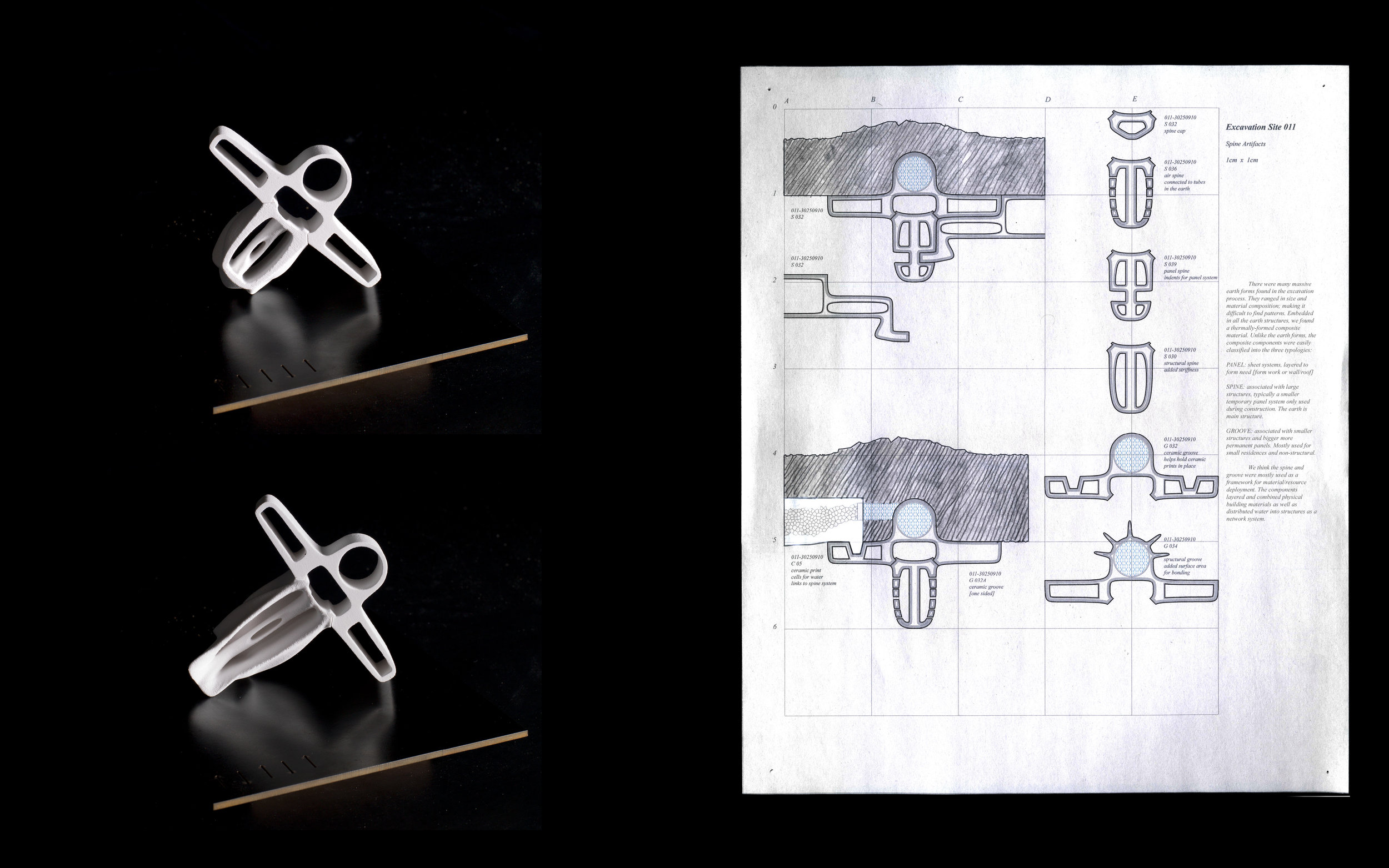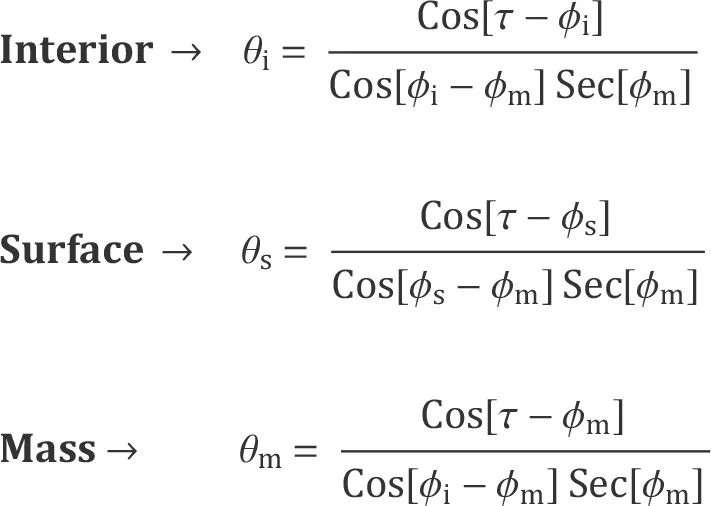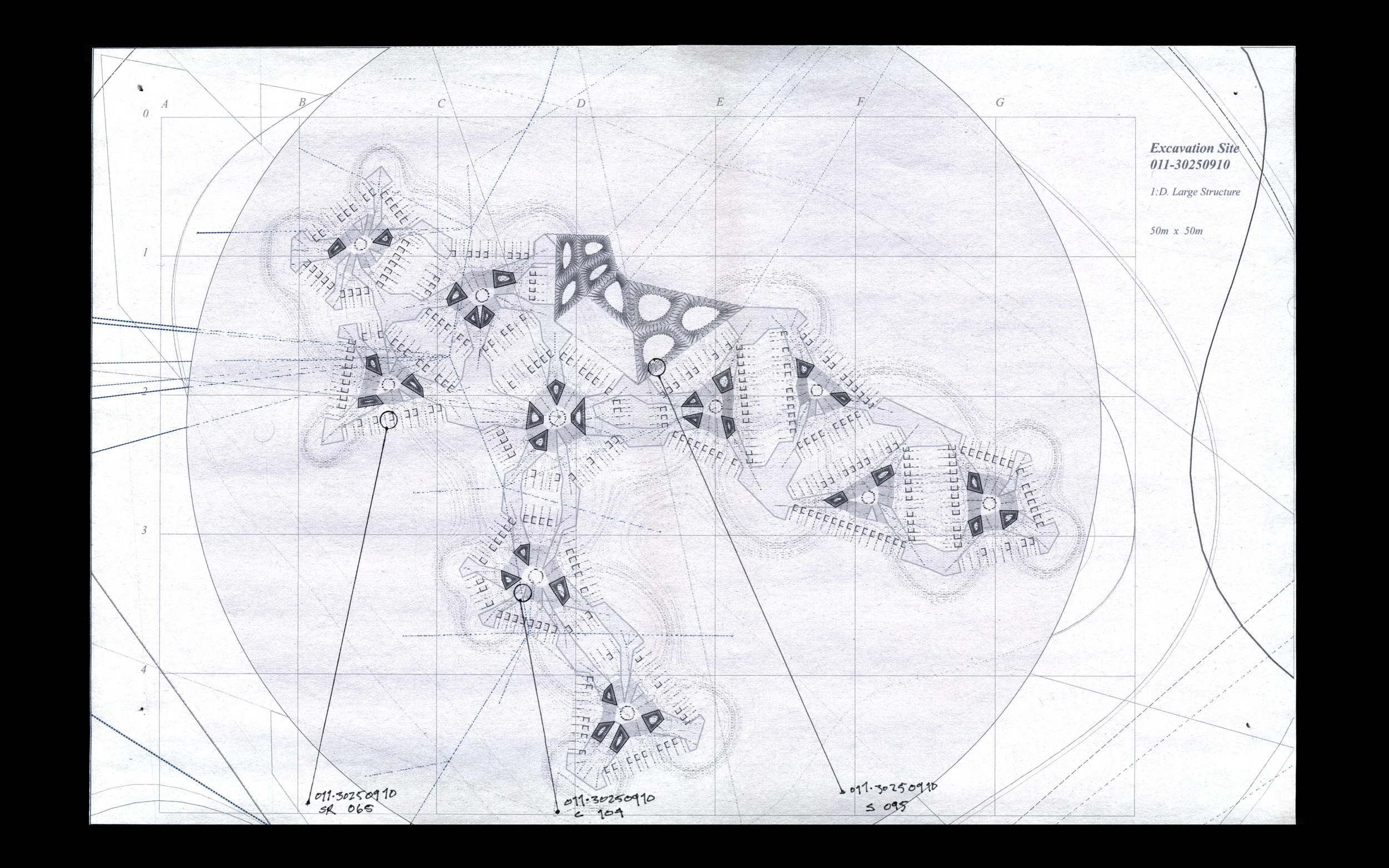Animitas para gaia
codelco mining camps of the 21st century
MAP OF 21ST CENTURY CHILE AND METALLOGENIC BELTS
Animitas para Gaia is an archaeology project based in the year 3030 AD. The excavation site takes place in the Aticama Desert where our research team was looking for traces of the CODELCO mining camps on earth. The state run mining company had mines along the length of the country and primarily mined for copper during the electrical age. The mining camps were presumed to be especially important in the legacy of off-world colonies because the mines were located in remote areas, like the Atacama Desert, and needed to be efficient in resources management and utilization. This material efficiency was the main objective of the research, not the material extraction techniques, and is assumed to be the basis of what we know today as sustainability. The main objective of the research was to investigate the links between mining, building and living as a reflection of cultural priorities and material efficiency.
PROJECTION OF COPPER VIENS FROM METALLOGENIC BELTS
The research team was able to identify the source of the mines easily due to the copper veins flowing beneath the surface of the desert. The mines were always closely organized according to this geological phenomenon. The colony near the pit was mostly buried from the tailings of the open pit mine. The research team concluded this from mineral testing which confirmed similar compositions from the near by mine. [The team would later come acknowledge the open pit mining was only one part of the extraction process, and another more technical drilling was done underneath the open pit mine. ] Although they were centuries old, the desert biosphere has very little effect on the landscape topography due to lack of water in the region.
3D PRINTED SEISMIC SCAN OF BURIED COLONY; DRAWING OF BURIED EXTRACTION SITE 011 AND SURROUNDING AREA
Underneath the layers of tailings were earthen structures made of a type of gypsum-based cement and soil. Interestingly, toxins from the waste water of the mine were also found inside the mineral composition of the structures, suggesting the miners had used waste water from the mine to construct the structures in which they inhabited. There were many earth forms found in the excavation process. They ranged in size and material composition; making it difficult to find patterns. However, connective infrastructure like pipes, cables and ducts were found linked to all structures regardless of size, suggesting a larger organization intelligence of the camp.
MODEL OF CONNECTED STRUCTURES, NOT IDENTIFIED; DETAIL DRAWING OF EXCAVATION SITE 011 BEFORE EARTH WAS REMOVED
During excavation, we discovered these seemingly ‘bone’ fragments in remarkable consistency. These thermally formed composite materials were commonly embedded inside the earthen structures. Unlike the earth forms in which these components were embedded, the composite components were easily classified into the three typologies: panel, spine and groove. From the positions and continuity of the components, the research team believes the spine and groove components were mostly used as a framework for which the panel components could temporarily attach. It is assumed this material/resource deployment technique produced a formwork system in which the gypsum-based cement and soil were built. After the panel components were removed, the spine and groove components remained as a structural system as well as distribution system of water, energy and air into the build forms as a network system. While the spine and groove components were mostly found intact inside the larger earthen structures, the panels were disperse and difficult to find. Because we do not have a complete set, we speculate the scarcity of panels is due to the fact that they were reused often, suggesting the population of the camp could fluctuate, as well as the position of the camp itself.
EXCAVATED SPINE COMPONENTS VARIOUS ATTACHMENTS; DETAILED DRAWING OF SPINE, GROOVE AND PANEL COMPONENT ASSEMBLY AND POSSIBLE CONSTRUCTION TECHNIQUE
MODEL OF SMALL AND FREQUENT EARTH STRUCTURES FOUND IN CLOSE PROXIMITY TO ONE ANOTHER; DETAILED DRAWING OF POSSIBLE PANEL ASSEMBLY WITH EARTH STRUCTURES
MODEL OF SMALL AND FREQUENT EARTH STRUCTURES FOUND IN CLOSE PROXIMITY TO ONE ANOTHER; DETAIL DRAWING OF SPATIAL COMPLEXITY AND AMOUNT OF SURFACE AREA PROVIDED BY EARTH STRUCTURES
MODELS OF VARYING GEOMETRIES FOUND; DETAIL DRAWING OF EXCAVATION SITE 011 AFTER EARTH WAS REMOVED
While the system of construction seemed to be understandable, the range of forms seemed to be an aesthetic choice from COLDELCO. This was proved wrong when the temperature began dropping below -10c during the nights. In a desperate attempt, the research team took shelter in one of the larger structures that had been recently uncovered. It was only then that the team felt the heat from the day returning to them via the lumped heat capacity of the material.
The temperature cycle of the structures were working the same as the daily temperature cycle, but less drastic and delayed. The research team noticed during the cool night, heat from the day that was stored in the thickness of the materials was then released back to the interior. As the structure cooled, the temperature of the day had already begun to climb and become hotter than the interior. Inversely, the cooled structure reduced the temperature of the air coming into the structure and began to heat up.
INTERIOR OF THERMAL RESONATOR WITH SPINE COMPONENTS INTACT AND PROJECTED AIR FLOW; SECTION OF THERMAL RESONATOR WITH MORPHING SURFACE AREA AND APPRETURES
With this near death experience, the research team hypothesized the formal array of the structures was not aesthetic, but in direct relation to the production of an interior climate. The team believed the dwellings for miners were designed and manipulated according to the variables of temperature difference [from interior to exterior], materials, and height.
From this hypothesis, the found shell constructions were interpreted as thermal mass. The exterior surface of the shell was the insulation and barrier of external temperatures and the interior surface, along with the mass of the shell, was the thermally interactive component. This morphology is produced by a reciprocal relationship between the height [H] and surface area [S] of the shell, and a series of apertures [A*] that are defined by a goal exchange rate and temperature difference.
In other words, the research team believed the CODELCO designers knew the material and thermal properties of the mass can be formally defined by determining the goal interior temperature.
Before designing the space, the COLDELCO designers needed to define [Fn] by setting both [ΩL] and [λ]. These three variables are linked in two resonance cycles: 1] the resonance between the air and the surface of the mass and 2] the resonance between the thermal storage of the mass and the surface of the mass. In order to find one variable, the other two must be set. Therefore, it is assumed [ΩL] is defined first by defining a material and depth that corresponds as a temperature lag between the interior surface. The order of operations is assumed as follows:
TEMPERATURE OF VARIABLE SIGNALS CONSTRAINED TO ONE ANOTHER
1] Set interior temperature goal. This temperature and corresponding temperature lags determine the material thermal storage needed because all the temperatures are constrained together.
THE TEMPERATURE OF MASS EVOLVES ACCORDING TO THE INTERIOR TEMPERATURE AND THE CONSERVATION OF ENERGY
MATERIAL PROPERTIES ACCORDING TO THE TEMPERATURE EVOLUTION OF MASS
CONSTRAINING THE TEMPERATURE EVOLUTION OF MASS TO MATCH THE EXISTING TEMPERATURE FREQUENCY
2] Determine an appropriate material and depth to meet required thermal storage. This produces the first resonance between the thermal mass and the surface of the mass.
3] Once the material and lumped capacitance is solved, the second resonance can be solved between the surface of the mass and the interior air.
THE EFFECTIVE HEAT TRANSFER COEFFICIENT BETWEEN MASS AND AIR FOR SPECIFIC CONSTRAINED TEMPERATURE EVOLUTION
4] The second resonance between the heat capacity of the air stream, and the convection across the entire surface of the mass is parameterized by [Fn].
Both [ΩL] and [λ] have been solved, so [Fn] can be isolated.
CLOSE SOLUTION BY LINKING THE RESONANCE OF THERMAL STORAGE AND SURFACE OF MASS TO AIR STREAM RESONANCE AND THE SURFACE OF MASS
5] Once [Fn] is known, the geometric properties of the space can be tuned to meet to specific resonance times required.
With this formula, we were able to recognize not only the change in in building form, but also the change in exterior temperature throughout the Anthropocene as new buildings were built over time.
INTERIOR TEMPERATURE SIGNAL AS DEFINED SPATIALLY BY VENTILATION RATE, SURFACE AREA, HEAT CAPACITY AND TRANSFER COEFFICIENT
SURFACE MORPHING OF THERMAL RESONATOR
PLUMES OF WATER RISING FROM THERMAL RESONATOR IN WATER BATH
HOT WATER RISING FROM THERMAL RESONATOR IN WATER BATH, DEMONSTRATING THE CHANGE OF FLUID WITHIN THE RESONATOR
DETAIL 30250910 OF NODE ORGANIZATION IN EXCAVATION SITE 011
Through further investigation, the material techniques of comfort via interior climate influenced social patterns inside the colony and established an active relationship between the miners and the geography/environment they were working in. Compared to the older mining camps of the Anthropocene, this colony integrated temperature cycles with social patterns into a node typology- sharing heat as well as social atmosphere. The configuration of smaller private structures surrounded large more public ones and created a courtyard effect.
DETAIL 30250911 OF NODE ORGANIZATION IN EXCAVATION SITE 011
At the same time we were investigating the placement and forms of materials, we were tracking the water system embedded in the composite components. We assumed inhabitants were drinking and cooking with the water supply. We also assumed the water inside the structural pieces was acting as part of the thermal mass. There is even some evidence that plant-life was deliberately grown to facilitate oxygen inside the sleeping compartments.
When tracing the water lines outside of the camp, the water supply seemed to be only linked to the mine. We know there was waste water from the mines, but if this was the only water source, it would have had to been treated before use. We did not find a typical treatment plant of the time near the excavation site, but further research provided another option of treatment: a passive water-treatment system at the Wheal Jane Tin Mine in 1992. The process included several cells: oxidation, limestone, and biochemical. While the system was successful, the amount of water treated was not etiquette due to the lack of land available.
When compared back to the excavation site and the larger scale, the research team realized the position of the colony in relation to the mine and the oasis was precise. We realized existing limestone fields were not for agriculture, the plant-life [biochemicals] were not only for oxygen, the mining colony was not only for miners; the colony itself was water treatment system. From the case study, we approximated the amount of water treatable from the area of the limestone fields. This was enough to supply inhabitants with enough drinking water. The water treatment defined a new relationship between the colony and the mine, as the colony depended on water from the mine. The treatment system also defined a new relationship between the land and the colony. The scale of developed land needed to treat the water forced the colony to function at a geographical scale.
MODEL OF LARGER STRUCTURES; DRAWING OF EXCAVATION SITE AND OTHER SITES IN RELATION TO MINE AND THE NETWORK OF WATER FLOW
This process of depending on waste water from the mine gives some clues to the duration of the colony. We know after the mine was closed, the colony stayed and continued to treat the water of the mine because there was no flooding in both the underground and open-pit mines. We presume the colony changed focus from mining to remediation after the mine closed. The life of the colony was not long lived after the mine. Because the mine was the ‘life-source’ for the colony, once the mine closed, the colony soon moved as well. With a geographic/existential relation to the land, we think the burial of the colony is more significant than economic reasons. We hypothesize the colonies became animitas in traditional Chilean culture; aimed at becoming a place of worship. Reminiscent of tragic events, animitas attempt to house the left souls from wandering the land.
If the colonies have turned into geographic animitas, then we know who died and we know who killed her.
The text, equations and images are edited excerpts. For more information, including references, please contact the author.





















